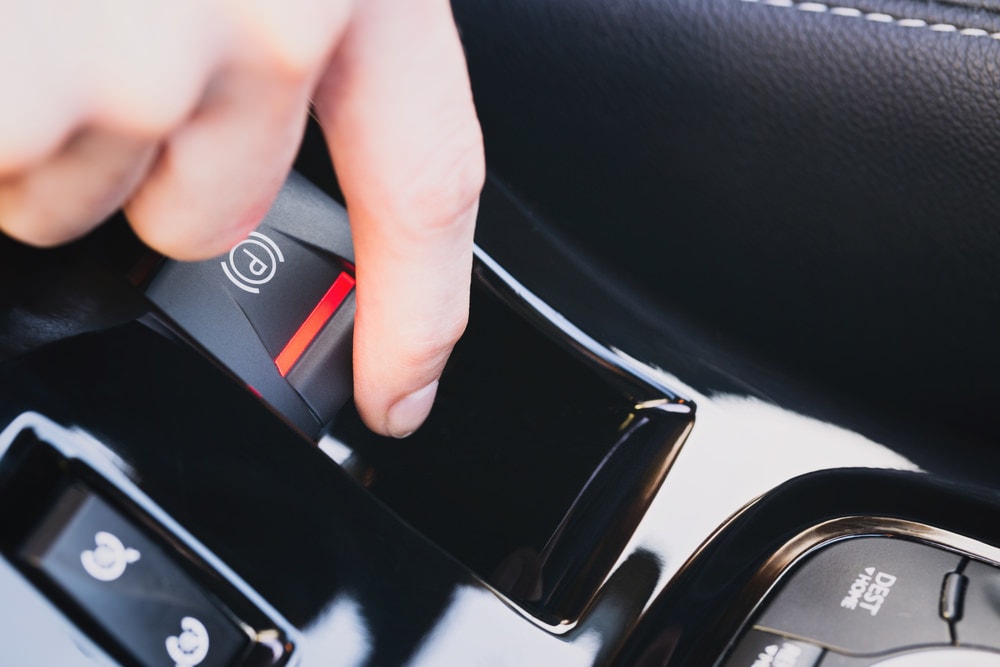

A parking brake (also known as an emergency brake) is part of the vehicle’s braking system. You will see a lever inside the car, often by the center console, which may be engaged when needed. Because of this lever, another term that is also used to describe the system is a handbrake.
What a Parking Brake Does
The original designation for a parking brake was to stop the vehicle if the main brake system should fail, which is why it was known as an emergency brake. In modern vehicles, the emergency brake isn’t very effective at this task because it cannot adequately stop the vehicle with the small amount of force applied. The parking brake is connected to the rear brakes, which do not exert as much force in braking as the front brakes and will do little to stop a vehicle moving at high speeds.
Most modern applications of the parking brake is to ensure that a parked vehicle stays in place, especially on hills and other declines. When engaged, it locks the wheels in place and works with the parking pawl to ensure that the vehicle doesn’t roll away. While a parking brake isn’t required to be engaged for the vehicle to stay stopped, it works to prevent your vehicle from rolling, especially on steep inclines, and to reduce stress on the transmission. This is why manufacturers recommend using the parking brake even when the driver doesn’t feel like he or she needs it.
When a vehicle’s gear shift is put into Park position, a parking pawl is engaged in the transmission. This is a pin that locks the gears into place to prevent them from rotating. The pawl stays in place until the gear shift is moved out of the Park position. The problem with relying on this mechanism for the vehicle is that it puts stress on the transmission constantly, which can result in eventual failure. Manufacturers recommend engaging the parking pawl after using the parking brake. The brake provides additional security and reduces the amount of stress on the transmission and driveline components to prevent costly repairs and parking failure.
Components of a Parking Brake
The typical parking brake has fewer components than the main brake system. They include variations of the following:
- A lever to engage and disengage the parking brake, found within the cabin of the vehicle
- Steel cables to connect to the main brakes of the vehicle located in the rear, often called a parking brake equalizer
The cable system features a “Y” design that allows a set of cables to be connected to each rear brake. A separate cable attaches to the equalizer or “Y” connection and the lever inside the vehicle. Often, these cables are contained inside an outer shell or shielded. The lever may have a separate button to deactivate the emergency brake. Some foot pedals require you to depress the foot brake twice to deactivate it.
Types of Parking Brakes
There are four basic types of parking brakes:
- Stick lever – found in older models and located under the instrument panel
- Center lever – located between front bucket seats and seen in many newer model vehicles
- Pedal – located on the floor to the left of the other pedals
- Electric or push button – located on console with other controls
How the Parking Brake Works with Various Systems
Because not all braking systems are identical, the differences impact how the parking brake works. Vehicles with automatic transmissions often have parking brakes with automatic releases while some later models require the main brake pedal to be depressed before the transmission can be switched out of park. Anytime Drive or Reverse is selected on the automatic transmission, the parking brake is automatically released. Older models would only require the gear shift to be moved without pressing down on the brake pedal.
The parking brake will press against rear drum brakes mechanically with a force that is less than what is used with the main braking system. With disc brakes, the emergency brake activates the calipers or a small drum brake that is contained within the hub of the disc. Larger vehicles often come with power-operated parking brakes or ones that are power assisted. The driver will pull the lever and hydraulic pressure is allowed into the brake cylinder, applying force to the brake shoes. This is an added safety mechanism that is often seen on commercial vehicles.
A recent development in parking brakes is the electric parking brake. It functions much the same way as the traditional parking brake, except that it engages at a push or pull of a button instead of using a mechanical lever. The more advanced designs even use a motor that is controlled by a computer to engage the parking brake. Some high-end luxury models have a system that automatically engages the parking brake when the engine is stopped. It is released once the gas pedal is pressed with no other human intervention necessary.
Issues with the Parking Brake
One of the main issues with the parking brake for owners is corrosion. When the parking brake is not engaged on a regular basis, it begins to corrode. Shielded cables are especially vulnerable because water and road debris gets trapped in the outer shell. You won’t realize there is a problem until you need the brake, which is why regular inspection is important. It is also recommended that you use your parking brake every time you park to keep it in working order.
With regular inspection and maintenance, you may never need to replace your parking brake. You want to ensure it is in good working order in case you must rely on it for any reason.



